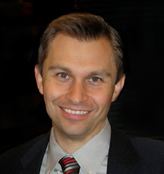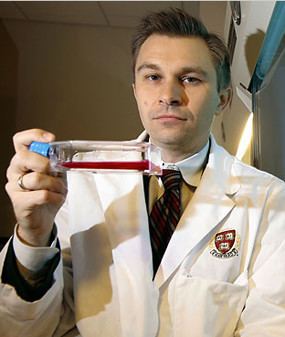Nationality Australian Influenced Rozalyn Anderson Fields Biology | Role Professor Name David Sinclair | |
 | ||
Institutions Paul F. Glenn Laboratories for the Biological Mechanisms of Aging at Harvard Medical School Education University of New South Wales | ||
Organizations founded Sirtris Pharmaceuticals | ||
David Andrew Sinclair (born ca 1969) is an Australian biologist and Professor of Genetics best known for his advocacy for resveratrol as an anti-aging dietary supplement and potential drug.
Contents

Early life
David Andrew Sinclair was born in Australia around 1969, and he grew up in St Ives, New South Wales; his paternal grandmother had immigrated to Australia following the failure of the Hungarian Revolution of 1956 and his father changed the family name from Szigeti to Sinclair.
Education and career
Sinclair obtained a Bachelor of Science at the University of New South Wales, Sydney, and received the Australian Commonwealth Prize. In 1995, he received a Ph.D. in Molecular Genetics from the same school, focusing on gene regulation in yeast. In 1993 he met Leonard P. Guarente, an Massachusetts Institute of Technology professor who studied genes involved in the regulation of aging, when Guarente was on a lecture tour in Australia, and the meeting spurred Sinclair to apply for a post-doc position in Guarente's lab. Earlier that year Cynthia Kenyon's lab at UCSF had discovered that a single-gene mutation in (Daf-2) could double the lifespan of C. elegans.
In 1999 Sinclair was hired at Harvard Medical School. In 2003 his lab was small and struggling for funding. In 2004 Sinclair met with the philanthropist Paul F. Glenn who ended up donating $5 million to Harvard to establish the Paul F. Glenn Laboratories for the Biological Mechanisms of Aging at Harvard, of which Sinclair became a director.
In 2004 Sinclair, along with serial entrepreneur Andrew Perlman, Christoph Westphal, Richard Aldrich, Richard Pops, and Paul Schimmel, founded Sirtris Pharmaceuticals. Sirtris was focused on developing Sinclair's research into activators of sirtuins, work that began in the Guarente lab. The company was specifically focused on resveratrol formulations and derivatives as activators of the SIRT1 enzyme; Sinclair became known for making statements about resveratrol like: “(It's) as close to a miraculous molecule as you can find.... One hundred years from now, people will maybe be taking these molecules on a daily basis to prevent heart disease, stroke, and cancer.” Most of the anti-aging field was more cautious, especially with regard to what else resveratrol might do in the body and its lack of bioavailability. The company's initial product was called SRT501, and was a formulation of resveratrol.; Sirtris went public in 2007 and was subsequently purchased and made a subsidiary of GlaxoSmithKline in 2008 for $720 million.
In 2006 Genocea Biosciences was founded based on work of Harvard scientist Darren E. Higgins around antigens that stimulate T cells and the use of these antigens to create vaccines; Sinclair was a co-founder.
In 2011, Sinclair was a co-founder of OvaScience with Michelle Dipp (who had been involved with Sirtris), Aldrich, Westphal, and Jonathan Tilly, based on scientific work done by Tilly concerning mammalian oogonial stem cells and work on mitochondria by Sinclair. Tilly's work was controversial, with some groups unable to replicate it.
In 2011 Sinclair was also a co-founder of CohBar, along with Nir Barzilai and other colleagues; CoBar aimed to discover and develop novel peptides derived from mitochondria.
In 2015 Sinclair described to The Scientist his efforts to get funding for his lab, how his lab grew to around 20 people, shrunk back down to about 5, and then grew again as he brought in funding from philanthropic organizations and companies, including companies that he helped to start. As of 2015 his lab had 22 people and was supported by one R01 grant and was 75% funded by non-federal funds.
Research
While Sinclair was in Guarente's lab, he discovered that Sirtuin 1 (called sir2 in yeast) slows aging in yeast by reducing the accumulation of extrachromosomal rDNA circles. Others working in the lab at the time identified NADH as an essential cofactor for sirtuin function. In 2002 after he had left for Harvard, he clashed with Guarente at a scientific meeting at Cold Spring Harbor Laboratory, challenging Guarante's description of how sir2 might be involved in aging; this set off a scientific rivalry.
In 2003, when his lab was still small, Sinclair learned that scientists at a Pennsylvania biotech company called Biomol Research Laboratories discovered that polyphenols including resveratrol could activate sir2, and he collaborated with them to confirm this. This led to publications authored in part by Sinclair in both Nature and Science in 2003. Sinclair's outspoken advocacy for resveratrol as an anti-aging compound started a scientific controversy over whether this was true, and whether resveratrol even activated sirtuins. Work in another lab, done partially funding from Sirtris, found increases in the number of mitochondria in the cells of mice given high doses of resveratrol. SInclair's lab continued to work on reservatrol and analogs of it, as well as mitochondria and NADH, all directed to understanding aging and how to prevent it.
